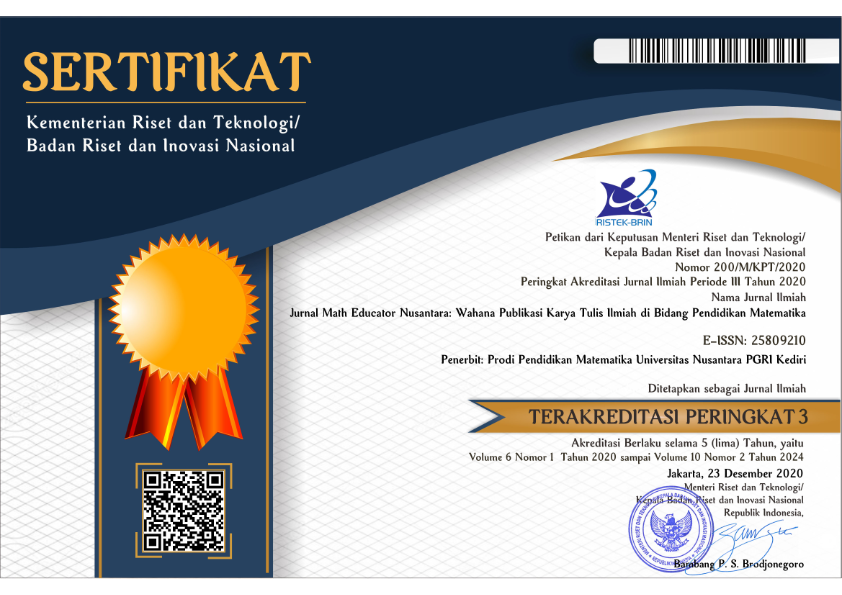Author Guidelines
- The articles contained results of research or study / conceptual thinking in the field of Mathematics and Mathematics Education. The article has not been or is not being processed for publication in other journals or periodicals, and not duplication / plagiarism from other articles. If it has been presented in a seminar forum, it should mention the name, place and date of the seminar.
- Research articles are written in order of: (a) Title, (b) Introduction, (c) Research Methods, (d) Research Results and Discussion; (e) Conclusions and Suggestions; and (f) References. Title includes: research title, author name, affiliate institution, author's email address, and abstract. Title written in Bahasa Indonesia, maximum 14 words. Abstracts are written in Indonesian or English, consisting of 1 paragraph, maximum of 150 words. The abstract contains the objectives, methods and results of research, and with the keyword (containing the characteristics of the problems contained in the article text, consisting of 1 or more words / phrases, maximum length of 1 line). The introduction contains background elements or situation analysis, urgency, and research objectives. Research Methods contain: subjects or targets of research, procedures, instruments, and techniques of data analysis, or other matters relating to the way research. Research and Discussion Results are written together, meaning that each unit of data is directly discussed. Conclusions and Suggestions are written in 1 heading. Conclusions can be generalizations of facts / findings, can also be an answer to research problems. Suggestions can be suggestions for improvements, and may also be implicative recommendations. The bibliography is written in the style of the American Psychological Association (APA).
- Conceptual review articles / thoughts (at the request of the editorial board) are written in order of: (a) Title, (b) Introduction, (c) Discussion, (d) Conclusions and Recommendations; and (e) References. Title includes: research title, author name, affiliate institution, author's email address, and abstract. Title written in Bahasa Indonesia, maximum 14 words. Abstracts are written in Indonesian or English, consisting of 1 paragraph, maximum of 150 words. The abstract contains the purpose / purpose of the review, scop / study material, as well as conclusions, and with the keyword (reflecting the characteristics of the problem, consisting of 1 or more words / phrases, maximum length of 1 line). The introduction contains background elements and or urgency of the study. The discussion contains analysis and discussion on the issues and / or the material being studied. The conclusion contains the essence of the study, it can also be the answer to the problems studied. Recommendations in the form of implicative suggestions or follow-up on the subject matter being reviewed. The bibliography is written according to APA style.
- Reference articles are in the form of journal and non-journal published in the last 10 years (maximum non-journal source only 20%), or up to date, according to research problem.
- The maximum script length is 15 pages A4. Articles written in Indonesian, typed in MS-Word letters Calibri, font 12, distance at least 16 (or 1.15 spaces). Top and left margin 2.5 cm, bottom and right 2.5 cm, left-right (justify). (examples of the grammar can be seen in the JMEN Articles Blogger, which can be accessed from http://ojs.unpkediri.ac.id/index.php/matematika )
- article script can be sent to OJS by login or register first if not yet have account, then you are required to confirm to email jme.nusantara@unpkediri.ac.id
- Classification of article acceptance: (1) Accepted without repair, (2) received with improvement, (3) Denied.
- Preparation of Bibliography that follows standard techniques must be done in a standard and consistent manner. To maintain consistency of referrals, cites and bibliography should use the Reference Manager application, such as Zotero, Mendeley, or other paid applications with APA 6th style. Written in a single space, the bibliography is spaced. Some examples of references / references in the Bibliography are given below.
American Psychological Association. (2019). Publication manual of the American Psychological Association (7th Ed.). Washington, DC: Author.
Bransford, J. D., Brown, A. L., & Cocking, R. R. (2005). How people learn: Brain, mind, experience and school. https://www.nap.edu/catalog/9853/how-people-learn-brainmind-experience-and-school-expanded-edition.
Tobias, S., & Duffy, T. M. (Eds.). (2009). Constructivist instruction: Success or failure? New York, NY: Routledge.
Sahlberg, P. (2012). The most wanted: Teachers and teacher education in Finland. In L. Darling-Hammond & A. Lieberman (Eds.). Teacher education around the world: changing policies and practices. London: Routledge, pp. 22-44.
Schunk, D. H. (2012a). Learning theories an educational perspective. Boston, MA: Pearson Education.
Schunk, D. H. (2012b). Learning theories: An educational perspective (E. Hamdiah & R. Fajar, Trans.). Yogyakarta: Pustaka Pelajar. (Original work published 2012).
Tabachnick, B. G., & Fidell, L. S. (2007). Using multivariate statistics (Fifth ed.). Needham Heights, MA: Allyn & Bacon.
Nurgiyantoro, B. & Efendi, A. (2017). Re-Actualization of puppet characters in modern Indonesian fictions of the 21 century. 3L: The Southeast Asian Journal of English Language Studies, 23(2), 141-153. doi: 10.17576/3L-2017-2302-11.
Retnowati, E., Fathoni, Y., & Chen, O. (2018). Mathematics problem solving skill acquisition: learning by problem posing or by problem solving? Cakrawala Pendidikan, 37(1), 1-10. doi: 10.21831/cp.v37i1.18787.
Booth, J. L., McGinn, K. M., Young, L. K., & Barbieri, C. (2015). Simple practice doesn’t always make perfect: Evidence from the worked example effect. Policy Insights from the Behavioral and Brain Sciences, 2(1), 24–32. doi: 10.1177/2372732215601691.
Retnowati, E. (2012, 24-27 November). Learning mathematics collaboratively or individually. Paper presented at the The 2nd International Conference of STEM in Education, Beijing Normal University, China. http://stem2012.bnu.edu.cn/data/short%20paper/stem2012_88.pdf.
NCTM (National Council of Teachers of Mathematics). (2000). Principles and standards for school mathematics. Reston, VA: Author.
Permendiknas RI 2009 No. 22. Kompetensi dasar pendidikan pancasila dan kewarganegaraan Sekolah Dasar Kelas I-VI. [Basic competence for pancasila and civil education Primary School Grade I-VI].
Writing instructions can be downloaded HERE (Indonesian)









